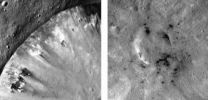(Press-News.org) When an embryonic stem cell is in the first stage of its development it has the potential to grow into any type of cell in the body, a state scientists call undifferentiated. A team of researchers from Scotland has now demonstrated a way to easily distinguish undifferentiated embryonic stem cells from later-stage stem cells whose fate is sealed. The results are published in the American Institute of Physics' (AIP) journal Biomicrofluidics. The researchers used an electric field to pull stem cells through a fluid in a process called dielectrophoresis. They varied the frequency of the voltage used to generate the electric field and studied how the cells moved, a response that was affected by the cell's electrical properties. The researchers found that differentiated stem cells could store a significantly greater charge on their outer membranes, a characteristic that might be used to effectively identify and separate them from undifferentiated cells. The researchers write that the wrinkling, folding, and thinning of a cell's membrane as it differentiates may explain why the later-stage cells can store more charge. The sorting method may prove useful in separating cells for biomedical research or ultimately for treatments of diseases such as Parkinson's.
###
Article: "Dielectrophoresis based discrimination of human embryonic stem cells from differentiating derivatives" is published in the journal Biomicrofluidics.
Link: http://bmf.aip.org/resource/1/biomgb/v6/i4/p044113_s1
Authors: Srinivas Velugotla (1), Steve Pells (2), Heidi K. Mjoseng (2), Cairnan R. E. Duffy (2), Stewart Smith (1), Paul De Sousa (2) and Ronald Pethig (1).
(1) Institute for Integrated Micro and Nano Systems, School of Engineering, The University of Edinburgh, Scotland
(2) Centre for Regenerative Medicine, College of Medicine and Veterinary Medicine, The University of Edinburgh, Scotland
Sorting stem cells
2013-01-04
ELSE PRESS RELEASES FROM THIS DATE:
New understanding of nerve damage caused by spinal cord injury could improve treatment design
2013-01-04
New Rochelle, NY, January 3, 2013—More than half of traumatic spinal cord injuries (SCI) in humans are cervical lesions, resulting in chronic loss of limb function. A better understanding of the link between the neurologic damage caused by SCI, spontaneous motor function recovery, and long-term motor deficits would lead to better therapeutic approaches, as discussed in an article in Journal of Neurotrauma, a peer-reviewed journal from Mary Ann Liebert, Inc., publishers. The article is available free on the Journal of Neurotrauma website at http://www.liebertpub.com/neu.
About ...
Carbon in Vesta's craters
2013-01-04
The protoplanet Vesta has been witness to an eventful past: images taken by the framing camera onboard NASA's space probe Dawn show two enormous craters in the southern hemisphere. The images were obtained during Dawn's year-long visit to Vesta that ended in September 2012. These huge impacts not only altered Vesta's shape, but also its surface composition. Scientists under the lead of the Max Planck Institute for Solar System Research in Katlenburg-Lindau in Germany have shown that impacting small asteroids delivered dark, carbonaceous material to the protoplanet. In the ...
Planets abound
2013-01-04
PASADENA, Calif.—Look up at the night sky and you'll see stars, sure. But you're also seeing planets—billions and billions of them. At least.
That's the conclusion of a new study by astronomers at the California Institute of Technology (Caltech) that provides yet more evidence that planetary systems are the cosmic norm. The team made their estimate while analyzing planets orbiting a star called Kepler-32—planets that are representative, they say, of the vast majority in the galaxy and thus serve as a perfect case study for understanding how most planets form.
"There's ...
Improving DNA amplification from problematic plants
2013-01-04
The polymerase chain reaction (PCR) is a common technique used to amplify, or copy, pieces of DNA. Amplified DNA is then used in genetic analyses for everything from medicine to forensics. In plant research, PCR is a vital step in detecting and sequencing genes, and its applications are endless. However, compounds found in plants often inhibit PCR. Researchers at the University of Southern Mississippi discovered that the use of an additive allows PCR to successfully amplify DNA from once problematic plants.
PCR is widely used in plant sciences but is not 100 percent ...
Plvap/PV1 critical to formation of the diaphragms in endothelial cells
2013-01-04
PV1 expression in vascular endothelium is required for survival
PV1 is required for the formation of stomatal and fenestral diaphragms
Lack of diaphragms in fenestrated endothelia causes vascular leak of plasma proteins
Vascular leak results in severe hypoproteinemia and hypertriglyceridemia
Dartmouth scientists have demonstrated the importance of the gene Plvap and the structures it forms in mammalian physiology in a study published in December by the journal Developmental Cell.
"The knowledge generated and the animal models created will allow a better understanding ...
Finding Chicago's food gardens with Google Earth
2013-01-04
Urban agriculture is promoted as a strategy for dealing with food insecurity, stimulating economic development, and combating diet-related health problems in cities. However, up to now, no one has known how much gardening is taking place in urban areas. Researchers at the University of Illinois have developed a methodology that they used to quantify the urban agriculture in Chicago.
John Taylor, a doctoral candidate working with crop sciences researcher Sarah Taylor Lovell, was skeptical about the lists of urban gardens provided to him by local non-governmental organizations ...
Dopamine-receptor gene variant linked to human longevity
2013-01-04
Irvine, Calif., Jan. 3, 2013 — A variant of a gene associated with active personality traits in humans seems to also be involved with living a longer life, UC Irvine and other researchers have found.
This derivative of a dopamine-receptor gene – called the DRD4 7R allele – appears in significantly higher rates in people more than 90 years old and is linked to lifespan increases in mouse studies.
Robert Moyzis, professor of biological chemistry at UC Irvine, and Dr. Nora Volkow, a psychiatrist who conducts research at the Brookhaven National Laboratory and also directs ...
2 NASA satellites see Cyclone Dumile over La Reunion and Mauritius
2013-01-04
NASA's Aqua and Terra satellites captured visible and infrared data on Tropical Cyclone Dumile as it slammed into the islands of La Reunion and Mauritius in the Southern Indian Ocean.
The Moderate Resolution Imaging Spectroradiometer (MODIS) instrument that flies aboard NASA's Terra satellite captured a visible image of Cyclone Dumile on Jan. 3, 2013 at 0650 UTC (1:50 a.m. EST/U.S.) The image showed Dumile's center was about 85 nautical miles (97.8 miles/157.4 km) northwest of Reunion Island and Mauritius, and the strongest thunderstorms appeared to be southwest of the ...
NASA sees Tropical Depression Sonamu form near Philippines
2013-01-04
The first Tropical Depression of 2013 formed the western North Pacific Ocean today, and NASA's Terra satellite captured an infrared image of the "birth."
Tropical Depression Sonamu, otherwise known as Tropical Depression 01W developed near 8.6 north latitude and 118.6 east longitude, about 185 nautical miles (213 miles/342.6 km) northwest of Zamboanga, Philippines. Sonamu's center is located in the Sulu Sea and is expected to cross the southern end of Palawan before moving into the open waters of the South China Sea.
Sonamu developed from low pressure System 92W. At ...
New rat model for muscle regeneration after trauma-related soft tissue injury
2013-01-04
New Rochelle, NY, January 3, 2013—Penetrating soft tissue injuries that may be caused by bullet wounds or motor vehicle accidents, or exposure to explosive devices in military settings, can cause muscle loss resulting in functional disability and cosmetic deformity. Efforts underway to develop tissue engineering solutions to repair and replace damaged and lost muscle will benefit greatly from the availability of robust animal models to test these innovative therapeutic strategies. A new rat model that simulates traumatic or surgical muscle tissue loss in humans is described ...





